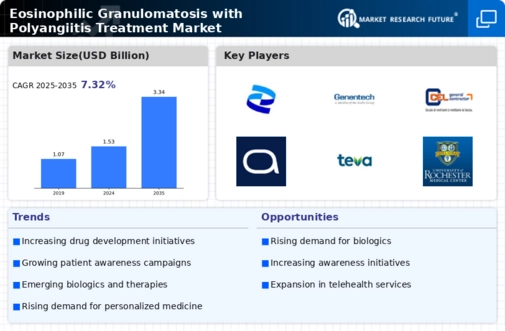Advancements in Diagnostic Techniques
The Eosinophilic Granulomatosis with Polyangiitis Treatment Market is experiencing a notable shift due to advancements in diagnostic techniques. Enhanced imaging technologies and biomarker identification have led to earlier and more accurate diagnoses. This is crucial, as timely intervention can significantly improve patient outcomes. The introduction of non-invasive diagnostic methods has also contributed to increased patient compliance and satisfaction. As a result, the market is witnessing a rise in the number of diagnosed cases, which in turn drives demand for effective treatment options. The growing emphasis on precision medicine further supports this trend, as healthcare providers seek to tailor treatments based on individual patient profiles. Consequently, the expansion of diagnostic capabilities is likely to play a pivotal role in shaping the future landscape of the Eosinophilic Granulomatosis with Polyangiitis Treatment Market.
Investment in Research and Development
Investment in research and development is a critical driver for the Eosinophilic Granulomatosis with Polyangiitis Treatment Market. Pharmaceutical companies are increasingly focusing on developing novel therapies to address the unmet medical needs of patients suffering from this condition. The potential for lucrative returns on investment is attracting significant funding, which is being directed towards clinical trials and the exploration of new treatment modalities. This influx of capital is likely to accelerate the pace of innovation, leading to the introduction of more effective and targeted therapies. Additionally, collaborations between academic institutions and industry players are fostering a conducive environment for groundbreaking research. As a result, the Eosinophilic Granulomatosis with Polyangiitis Treatment Market is poised for substantial growth, driven by the continuous evolution of treatment options.
Growing Patient Advocacy and Support Groups
The emergence of patient advocacy and support groups is playing a vital role in the Eosinophilic Granulomatosis with Polyangiitis Treatment Market. These organizations are instrumental in raising awareness about the disease, educating patients and healthcare providers, and promoting research initiatives. By fostering a community of support, they empower patients to seek timely medical attention and adhere to treatment regimens. Furthermore, these groups often collaborate with pharmaceutical companies to facilitate clinical trials, ensuring that patient perspectives are considered in the development of new therapies. The increased visibility of Eosinophilic Granulomatosis with Polyangiitis through advocacy efforts is likely to lead to higher diagnosis rates and, consequently, a greater demand for effective treatment options. This dynamic is expected to enhance the overall market landscape and drive growth in the industry.
Regulatory Support for Innovative Therapies
Regulatory support for innovative therapies is emerging as a significant driver in the Eosinophilic Granulomatosis with Polyangiitis Treatment Market. Regulatory agencies are increasingly recognizing the need for expedited approval processes for treatments targeting rare diseases. This shift is encouraging pharmaceutical companies to invest in the development of novel therapies, including biologics and gene therapies. The potential for fast-tracked approvals not only reduces the time to market but also enhances the attractiveness of investing in research for Eosinophilic Granulomatosis with Polyangiitis treatments. As a result, the market is likely to witness a surge in the availability of new and effective treatment options, ultimately benefiting patients and healthcare providers alike. This regulatory environment is expected to foster innovation and drive growth within the Eosinophilic Granulomatosis with Polyangiitis Treatment Market.
Rising Incidence of Eosinophilic Granulomatosis with Polyangiitis
The Eosinophilic Granulomatosis with Polyangiitis Treatment Market is significantly influenced by the rising incidence of this rare autoimmune condition. Recent epidemiological studies indicate an increase in the prevalence of the disease, which is prompting healthcare systems to allocate more resources towards its management. The growing number of diagnosed cases is expected to drive the demand for innovative treatment options, including biologics and immunosuppressants. Furthermore, as awareness of the disease increases among healthcare professionals and patients alike, more individuals are likely to seek medical attention, leading to earlier diagnosis and treatment initiation. This trend is anticipated to create a robust market environment, fostering the development of new therapies and enhancing the overall treatment landscape for Eosinophilic Granulomatosis with Polyangiitis.

















Leave a Comment